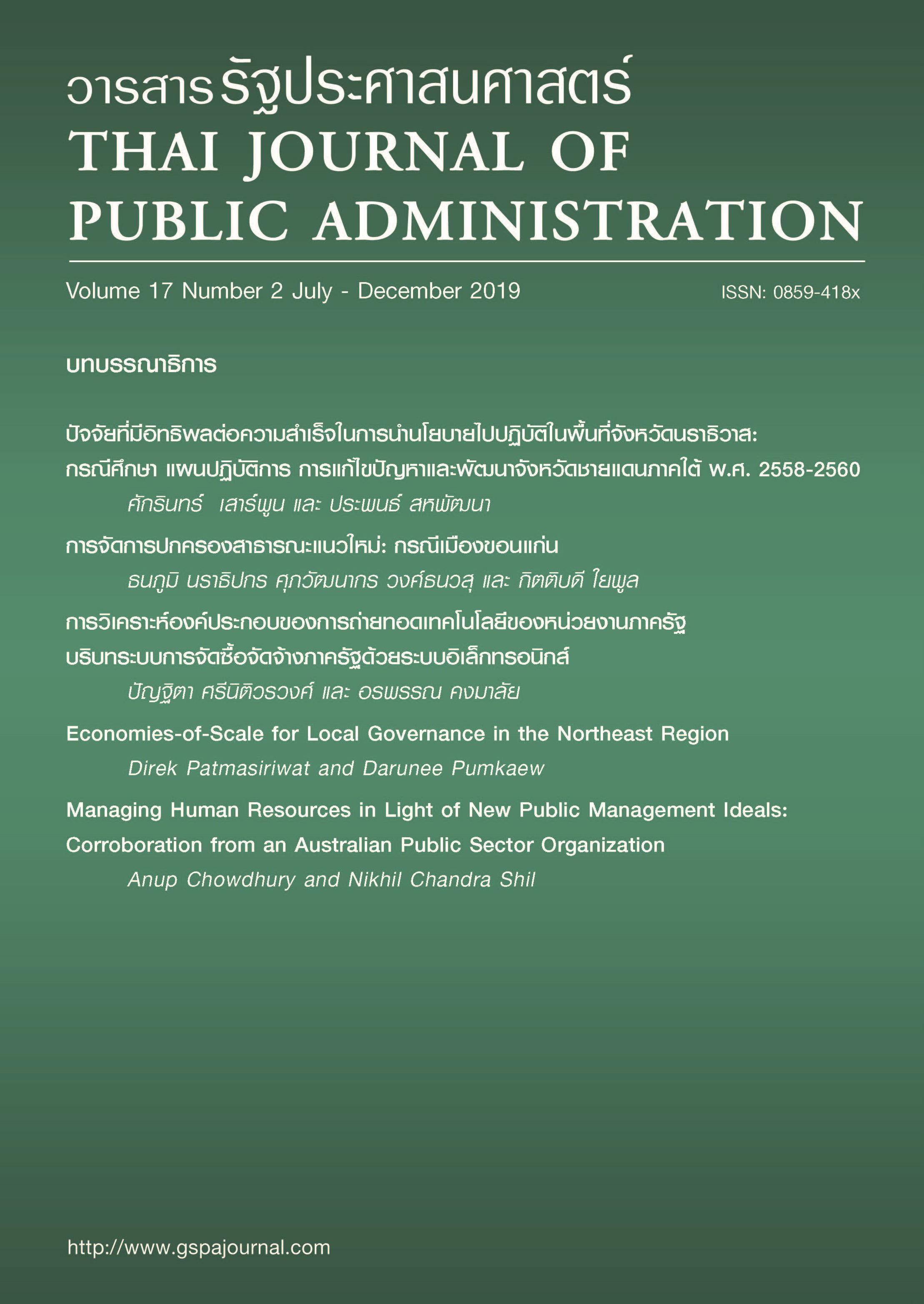Factors Affecting Government Technology Transfers: Electronic Procurement in the Thai Government
Keywords:
Government technology transfer, e-GP, electronic procurement, government innovation, exploratory factor analysisAbstract
This study aims to identify factors behind successful technology transfers between the central government and other government organizations and state enterprises. The research focuses on the context of Electronic Government Procurement or e-GP and sender and receiver characteristics within the context of technology transfer, absorptive capacity, and government technology transfer theories. Data were collected via specialist interviews and a questionnaire distributed to a sample of respondents from organizations that had most decreased their procurement costs through the use of an e-GP system; namely, the Electricity Generating Authority of Thailand (EGAT), the Provincial Electricity Authority (PEA), the Department of Highways, and the Department of Rural Roads. A total of 500 usable questionnaires were collected (a 96.15 percent response rate). Exploratory factor analysis (EFA) and confirmatory factor analysis (CFA) were used in the data analysis. The results indicate a number of differences between senders and receivers. Among the three dimensions of sender characteristics, the most important was sender willingness. Of the three receiver characteristics, the most important was their absorptive capacityง
References
Bozeman, B., & Coker, K. (1992). Assessing the effectiveness of technology transfer from US government R&D laboratories: The impact of market orientation. Technovation, 12(4), 239-255.
Buratti, N., & Penco, L. (2001). Assisted technology transfer to SMEs: Lessons from an exemplary case. Technovation, 21(1), 35-43.
Dardak, R., & Adham, K. (2014). Transferring agricultural technology from government research institution to private firms in Malaysia. Procedia-Social and Behavioral
Sciences, 115.
Ganesan, S., & Kelsey, J. (2006). Technology transfer: International collaboration in Sri Lanka. Construction Management and Economics, 24(7), 743-753.
Groden, J., Diller, A., Bausman, M., & Velicar, W. F. (2001). The Development of a stress survey schedule for persons with autism and other developmental disabilities. Journal of Autism and Developmental Disorders, 31(2).
Gwon, S., Kang, J., Kim, S., & Cho, K. (2013). Determinants of successful technology commercialization: Implication for Korean government-sponsored SMEs. Asian Journal of Technology Innovation, 21.
Hair, J., Black, W., Babin, B. J., Anderson, R. E., & Tatham, R. L. (2014). Multivariate Data Analysis. London: Pearson Education International.
Hamid, N. A., & Salim, J. (2011). A conceptual framework of knowledge transfer in Malaysia e- government IT outsourcing: An integration with transactive memory system (TMS). International Journal of Computer Science Issues, 8(5), 51-64.
Ishihara, H., & Zolkiewski, J. (2017). Effective knowledge transfer between the headquarters and a subsidiary in a MNC: The need for heeding capacity. Journal of Business & Industrial Marketing, 32(6), 813-824.
Jun, Y., & Ji, l. (2016). Demand-pull technology transfer and needs-articulation of users: A preliminary study. Procedia Computer Science, 91, 287-295.
Kaliannan, M., Awang, H., & Raman, M. (2009). Electronic procurement: A case study of Malaysia’s e-Perolehan (e-procurement) initiative. International Journal of Electronic Governance, 2, 101-115.
Kong, L., Ciabuschi, F., & Martín, O.M. (2018). Expatriate managers’ relationships and reverse knowledge transfer within emerging market MNCs: The mediating role of subsidiary willingness. Journal of Business Research, 93(C), 216-229.
Lavoie, J. R., Kim, J., & Daim, T. U. (2017). A technology transfer framework: A case study from the energy sector. International Journal of Innovation, Management and Technology, 8(4).
Masaaki, K., Karunamoorthy, S., & Aulakh, P. S. (2002). Multinationality and firm performance: The moderating role of R & D and marketing capabilities. Journal of International Business Studies, 33(1), 79-97.
Meijer, L., Huijben, J., Boxstael, A. v., & Romme, A. (2019). Barriers and drivers for technology commercialization by SMEs in the Dutch sustainable energy sector. Renewable and Sustainable Energy Reviews, 112, 114-126.
Minbaeva, D., Park, C., Vertinsky, l., & Cho, Y. S. (2018). Disseminative capacity and knowledge acquisition from foreign partners in international joint ventures. Journal of World Business, 53(5), 712-724.
Minbaeva, D., Pedersen, T., Björkman, I., Fey, C. F., & Park, H. (2014). MNC knowledge transfer, subsidiary absorptive capacity and HRM. Journal of International Business Studies, 45(1), 38-51.
Mudalige, D., & Perera, C. (2011). A case study of technology transfer process in a government research organization in Sri Lanka. Wayamba Journal of Management, 3.
Nunnally, J. C. (1978). Psychometric Theory. New York: McGraw Hill.
Olajumoke, A., Oladipo, O. G., & Adeyeye, A. D. (2013). What drives technology utilization, learning and transfer in agriculture? Scientific Papers Series: Management, Economic Engineering in Agriculture and Rural Development, 13(2).
Purushotham, H., Vaithianathan, S., & Sunder, C. S. (2015). Structural equation modeling (SEM) approach to identify critical success factors of technology transfer: An empirical analysis from Indian context. Advances in Industrial Engineering and Management, 4(2), 123-146.
Schumacker, R., & Lomax, R. (2010). A Beginner’s Guide to Structural Equation Modeling. 3rd edition. Abingdon, OX: Taylor and Francis Group.
Shaker, Z. A., & Gerard, G. (2002). Absorptive capacity: A review, reconceptualization, and extension. The Academy of Management Review, 27(2).
Simona, G., & Axèle, G. (2012). Knowledge transfer from TNCs and upgrading of domestic firms: The Polish automotive sector. World Development, 40(4), 796-807.
Takim, R., Omar, R., & Nawawi, A. H. (2008). International technology transfer (ITT) projects and development of technological capabilities in Malaysian construction industry: A conceptual framework. Asian Social Science, 4(8).
The Comptroller General’s Department. (B.E.2561). Komoon Khan Chadsue Chadchang Chak Rabob Chadsue Chadchang Pak Rat -Government Procurement (e-GP) B.E.2560.
Wang, P., Tong, T., & Koh, C. P. (2004). An integrated model of knowledge transfer from MNC parent to China subsidiary. Journal of World Business, 39(2), 168-182.
Waroonkun, T., & Stewart, R. (2008). Modeling the international technology transfer process in construction projects: Evidence from Thailand. The Journal of Technology Transfer, 33(6), 667-687.
Xu, Q., & Ma, Q. (2008). Determinants of ERP implementation knowledge transfer. Information & Management, 45(8), 528-539.
Downloads
Published
Issue
Section
License

This work is licensed under a Creative Commons Attribution-NonCommercial-NoDerivatives 4.0 International License.



